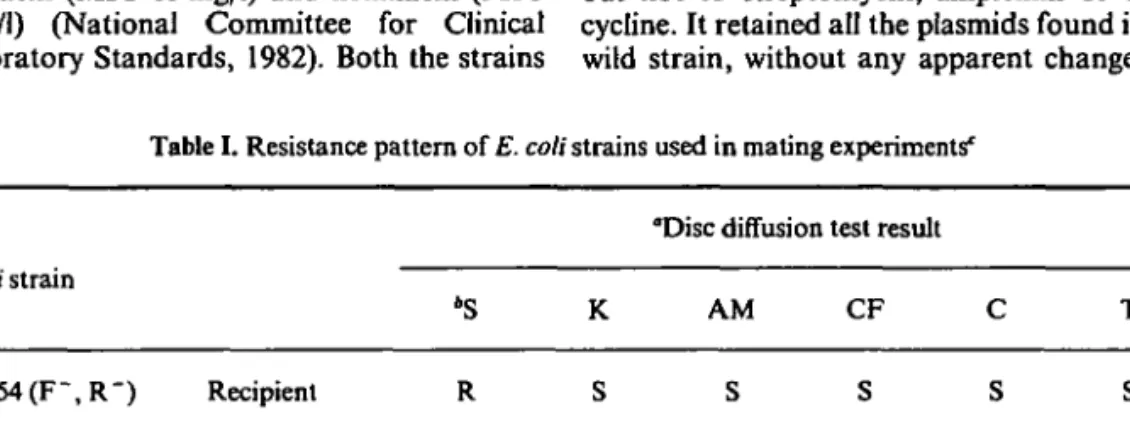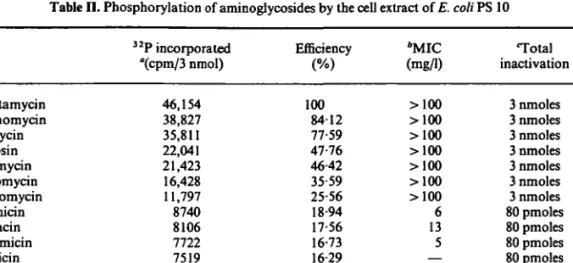Journal of Antimicrobial Chemotherapy (1985) 16,401-408
Correspondence
A unique aminoglycoside-O-phosphorylating transferred the kanamycin resistance along activity mediating resistance to aminoglycosides with ampicillin resistance to the recipient strain in Escherichia colt HK 254 (F ~, R ", Lac " ) by conjugation (Table I), at a frequency of 10 "2 and 10 "3 respec-Sir, tively. However, strain PS 5 alone transferred The limitation of disc diffusion tests was resistance to tetracycline as well. The transfer recently illustrated by a report on the failure of of resistance markers in E. coli PS 5 was the test to detect moderate levels of resistance mediated by a plasmid that was > 54-2 kb and to tobramycin in kanamycin-resistant strains that could be eliminated by treatment with of Escherichia coli (Santanam, 1984). The acriflavin. The resulting derivative was resistance in two representative strains was phenotypically susceptible to kanamycin, found to be mediated by an amfnoglycoside- streptomycin, ampicillin and tetracycline by O-phosphorylating enzymatic activity having disc diffusion tests (Table I). Strain PS 10, in a novel spectrum of substrates. This report addition to a large plasmid similar to the one presents the results of additional studies on the found in PS 5, had two other detectable phosphorylating activity and its genetic basis in plasmids with a size of 6-1 kb and 5-4 kb. the two strains. However, treatment of PS 10 with acriflavin
The two strains PS 5 and PS 10, having a selectively eliminated resistance only to moderate level of resistance to gentamicin and kanamycin. The resulting derivative was tobramycin (MICs '5 mg/1), were susceptible to phenotypically susceptible only to kanamycin, amikacin (MIC 13 mg/1) and netilmicin (MIC but not to streptomycin, ampicillin or tetra-6 mg/1) (National Committee for Clinical cycline. It retained all the plasmids found in the Laboratory Standards, 1982). Both the strains wild strain, without any apparent change due
Table I. Resistance pattern of E. coli strains used in mating experiments'
E. coli strain HK254(F",R-) Lac-PS 5 Lac+ PS5-HK254 PS5(E) PS 10 Lac+ PS10-HK254 PS 10 (E) Recipient Donor Trans-conj Eliminanf1 Donor Trans-conj Eliminant >S R R R S R R R K S R R S R R S
"Disc diffusion test resul AM S R R S R R R CF S S S
s
R S R t Cs
s
s
s
Rs
s
Ts
R R S R S S °R, Resistant; S, susceptible*S, Streptomycin; K., kanamycin; AM, ampicillin; CF, cephalothin; C, chloramphenicol; T, tetracycline
cMating was performed first by growing for 4 h at 37°C cultures of the donor and the recipient grown
over-night and diluted in brain-heart infusion (BHI) to 1:10 and 1:100 respectively. One millilitre of the donor culture was mixed with 4-5 ml of the recipient, the volume made up to 10 ml in BHI and incubated at 37°C. Transconjugants were selected from 100 ul samples taken after 2 h and 24 h of incubation, on Mackonkey agar incorporating 4000 mg/1 of streptomycin and 500 mg/1 of kanamycin.
'Eliminants were selected from BHI cultures incorporating with 16 mg/1 of acriflavin stored at 37°C for 4 weeks.
4 0 2 Correspondence
Table II. Phosphorylation of aminoglycosides by the cell extract of E. coli PS 10
Drug Ribostamycin Paromomycin Neomycin Butirosin Kanamycin Lividomycin Streptomycin Netilmicin Amikacin Gentamicin Sisomicin Tobramycin Dibekacin Spectinomycin 32P incorporated °(cpm/3 nmol) 46,154 38,827 35,811 22,041 21,423 16,428 11,797 8740 8106 7722 7519 2940 2941 0 Efficiency (%) 100 8412 77-59 47-76 46-42 35-59 25-56 18-94 17-56 16-73 16-29 6-37 6-37 0 *MIC (mg/1) >100 >100 >100 >100 >100 >100 >100 6 13 5 — 5 — — Total inactivation 3 nmoles 3 nmoles 3 nmoles 3 nmoles 3 nmoles 3 nmoles 3 nmoles 80 pmoles 80 pmoles 80 pmoles 80 pmoles 80 pmoles 80 pmoles not tested
° A value of 978 cpm from the control without drug has been deducted from the experimental values.
* MIC was tested by spreading a suspension of 1 x 10' to 4 x 10' cells in 100 ul of Mueller-Hinton broth on Mueller-Hinton agar containing an aminoglycoside as described elsewhere (Santanam, 1984).
' Total inactivation was determined by the microbiological assay (Santanam & Kayser, 1976a).
to loss of the kanamycin resistance as discerned by agarose gel electrophoresis of plasmid DNA (Kieser, 1984).
The cell extract obtained by the osmotic shock procedure (Santanam & Kayser, 19766), phosphorylated ribostamycin with maximum efficiency (Table II). The efficiency of phos-phorylation of netilmicin and amikacin was 16% that of ribostamycin and that of tobramy-cin and dibekatobramy-cin was only 6%. Phosphoryla-tion resulted in the inactivaPhosphoryla-tion of the drugs tested in the range of 3 nmoles to 80 pmoles (Santanam & Kayser, 1976a).
The phosphorylating activity described here has a unique spectrum of substrates that encompasses the spectrum of substrates of both aminoglycoside-O-phosphotransferase (3') III and aminoglycoside-O-phosphotransferase (2") (Foster, 1983) both of which are usually associated with Gram-positive organisms. Since 3', 4'-dideoxykanamycin B (dibekacin) and gentamicin, in addition to tobramycin, are substrates for the enzymatic activity, phosphorylation occurs presumably in the deoxystreptamine moiety (ring II) or amino-hexose HI of the aminoglycoside molecule. Whether phosphorylation of the different hydroxyl groups is mediated by a single novel enzyme or by a combination of enzymes remains to be determined, as does the exact molecular weight of the large plasmid.
This work was presented in part at the 4th Mediterranean Congress of Chemotherapy
held in Rhodos, Greece, during October 1984 (abstract no. 404).
P. SANTANAM L. MAINO F. H. KAYSER
Institute for Medical Microbiology, University of Zurich.
Gloriastrasse-32, . CH-8028 Zurich,
Switzerland
References
Foster, T. J. (1983). Plasmid-determined resistance to antimicrobial drugs and toxic metal ions in bac-teria. Microbiological Reviews 47,361-409. Kieser, T. (1984). Factors affecting the isolation of
ccc DNA from Streptomyces lividans and
Escherichia coli. Plasmid 12, 19-36.
National Committee for Clinical Laboratory Stan-dards. (1982). Performance standards for anti-microbic disc susceptibility tests. Second Supple-ment, Vol. 2. National Committee for Clinical Laboratory Standards, Villanova, Pa.
Santanam, P. (1984). Failure of the disk diffusion test to detect tobramycin resistance in kanamycin-resistant Escherichia coli strains. Journal of Clinical
Microbiology 20,295-7.
Santanam, P. & Kayser, F. H. (1976a). Tobramycin adenylyltransferase: A new aminoglycoside inacti-vating enzyme from Staphylococcus epidermidis.
Journal of Infectious Diseases 134, Suppl., S33-9.
Santanam, P. & Kayser, F. H. (1976i). Enzymatic adenylylation by aminoglycoside 4'-adenylyl-transferase and 2"-adenylyl4'-adenylyl-transferase as a means of determining concentration of aminoglycoside antibiotics in serum. Antimicrobial Agents and

